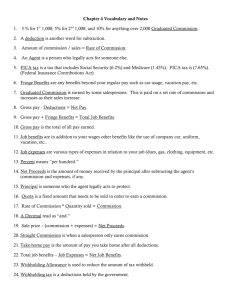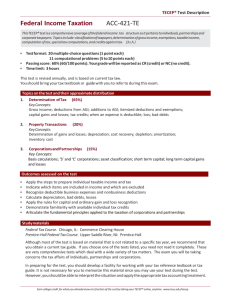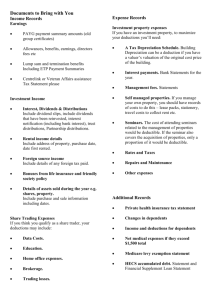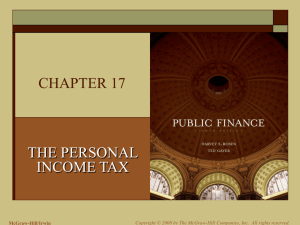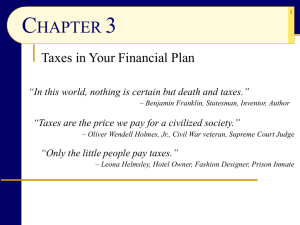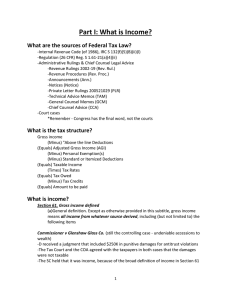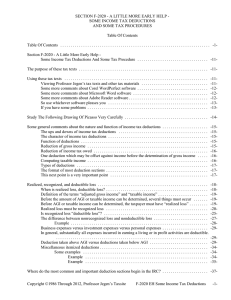File
advertisement
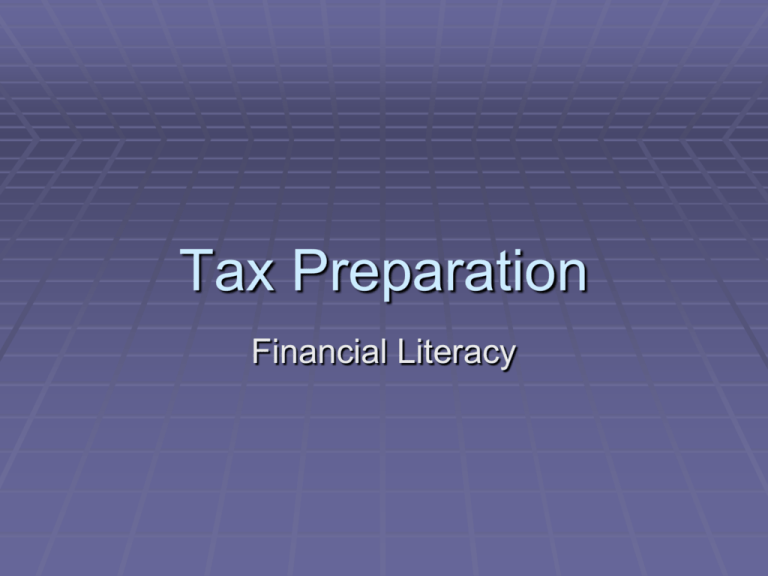
Tax Preparation Financial Literacy Federal Income Tax Structure The Federal income tax is a progressive tax The higher your income, the more you pay, both as a dollar amount and as a percentage. Tax Freedom Day (see Facts of Life, page 102) Almost four months of your yearly income goes to pay various taxes (30%) Tax Vocabulary Tax Brackets: Income ranges in which the same tax rates apply For example: 15%, 25%, 35%, etc. Personal Exemptions: An allowed reduction in your income before taxes are computed You get one for yourself, one for your spouse, and one for each dependent Tax Vocabulary, continued Deductions are: Expenses that reduce taxable income, such as: Some medical expenses Mortgage interest paid State and local income taxes Charitable contributions Itemized Deductions (expenses): Deductions are calculated using Schedule A Tax Vocabulary, continued Standard Deduction: A set deduction allowed by the IRS regardless of your actual expenses You can itemize deductions or take the standard deduction, but not both Taxable Income: Income subject to taxes after deductions and exemptions are subtracted from gross income Tax Example Gross income – exemptions – deductions = Taxable Income Assuming you are married filing jointly with gross income of $70,000 and taxable income of $49,423, your taxes would be $6,564 (see Figure 4.4 on page 109) Marginal Tax Rate This chart shows the highest tax rates charged for the highest incomes over the last 100 years. The Fiscal Cliff agreement raised the highest tax rate to 39.6% on the highest earners Average vs Marginal Tax Rates Marginal tax rates are the percentage paid on your highest level of income Marginal tax rate in the example is 25% Average tax rates are your actual taxes divided by your taxable income (will be lower than the marginal rate): $6,564/$49,423 = 13.28% Or by your gross income: $6,564/$70,000 = 9.38% Filing Status Single: You are single at the end of the year with no dependents Married filing jointly: You and your spouse combine incomes Married filing separately: You and your spouse file separate returns Head of Household: You are unmarried but have at least one dependent child living with you Other Taxes You Pay Social Security (FICA) 6.2% for Social Security 1.45% for Medicare State and local income taxes Excise taxes: Sales taxes, gas taxes, property taxes, taxes on liquor, cigarettes, jewelry, air travel, etc. Gift and estate taxes Who Has To File A Return? If your income is greater than $20,900 If it is less than that, you might not need to file, depending on your circumstances (check with your tax advisor) However, if your income is less than that and if you had taxes withheld, you will not get a refund unless you file a return. Itemizing Deductions The most common deductions are: Medical and dental expenses exceed 7.5% of adjusted gross income Tax expenses (state and local can be deducted, but not Federal, Social Security, or sales taxes) Home mortgage interest Charitable contributions Casualty and theft losses A deduction will lower your tax bill, but not dollar for dollar Standard Deduction The standard deduction is the government’s best estimate on what the average person would be able to deduct by itemizing Remember that you can take the standard deduction or you can itemize, but not both See Figure 4.2 for standard deduction amounts (page 106) Exemptions Personal Take one for yourself and one for your spouse Dependents: Must have a qualifying relationship (child, grandchild, parents, stepparents, uncles, nieces, etc.) • The dependent can’t earn more than the exemption amount does not apply to children under 19 or to children under 24 if full-time students Must provide more than half of dependent’s financial support Tax Formula Gross Income: Sum of Income from all sources Less Adjustments to gross income: tax-deductible expenses and retirement contributions (IRA, 401K), moving expenses, etc. Equals Adjusted Gross Income Less Equals Taxable income Exemptions and deductions Calculating Your Base Income Tax For most taxpayers, this is calculated using tax tables (see page 109) Tax tables have tax brackets built in Once taxes have been calculated, credits can be deducted Common Income Tax Credits Tax credits will lower your tax bill, dollar for dollar. Examples: Child Tax Credit (this can become a refund for parents who don’t pay taxes) up to $1000 per child American Opportunity Credit Credit for tuition, up to $2500 of the first $4,000 of educational expenses Child and dependent care credit Credit for money paid for child or other dependent care Earned income credit For low-income families, may result in negative taxes paid Income Tax Due Base Income Tax Less Tax Credits Equals Total Income Tax Due Picking a Tax Form Options: 1040EZ, 1040A, or 1040 1040EZ: No dependents, taxable income less than $50,000, no itemizing deductions 1040A: No itemizing, alimony, capital gains, pension or Social Security benefits; income less than $50,000 1040: everyone else
